Coming into this year’s Copa America, Colombia are one of the dark horses of the tournament. As of right now, there is not much we know about the team, the coach’s intention or the style of play he’s planning to instil.
What we do know, however, is that Colombia will be heading into the event with a quality squad but still with a sour taste in their mouth following somewhat disappointing results from both the last Copa America and the 2018 World Cup in Russia. Speaking of the latter, perhaps the word ‘controversy’ fits the narrative the best here. Colombia couldn’t get past England in the round of 16 of the competition after a series of unfortunate and questionable decisions went against them.
The whole situation ultimately led to the departure of the longtime coach José Pékerman who was replaced by Arturo Reyes in 2018. But the new gaffer would only last four games in total, giving way to Carlos Queiroz just in time for the 2019 Copa America. But despite an excellent group stage and good feelings going into the knockout rounds, Colombia couldn’t get the better of Chile, bowing down the opposition after a penalty shootout.
This, along with a rather disappointing start to the 2022 World Cup, qualifiers resulted in Queiroz also getting the sack, leaving Colombia with their third coach since 2018 – Reinaldo Rueda. The former Colombia, Honduras and Chile manager took over in January this year and due to various postponements, he is yet to play his first game as the new coach.
Intriguingly, Rueda was the one who eliminated Colombia from the 2019 Copa America as he was at the helm of that Chile team that sent the Los Cafeteros packing. Needless to say, some of the fans might still be unconvinced by the appointment but he is a local man with enough experience and prestige to lead them to a successful campaign.
One of his greatest feats is winning the Copa Libertadores with Atlético Nacional in 2016. Can he restore Colombia’s pride and lead them to glory in a tournament they’ve won only once but have been to the final twice in their history?
We’ll have to wait and see.
THE SQUAD
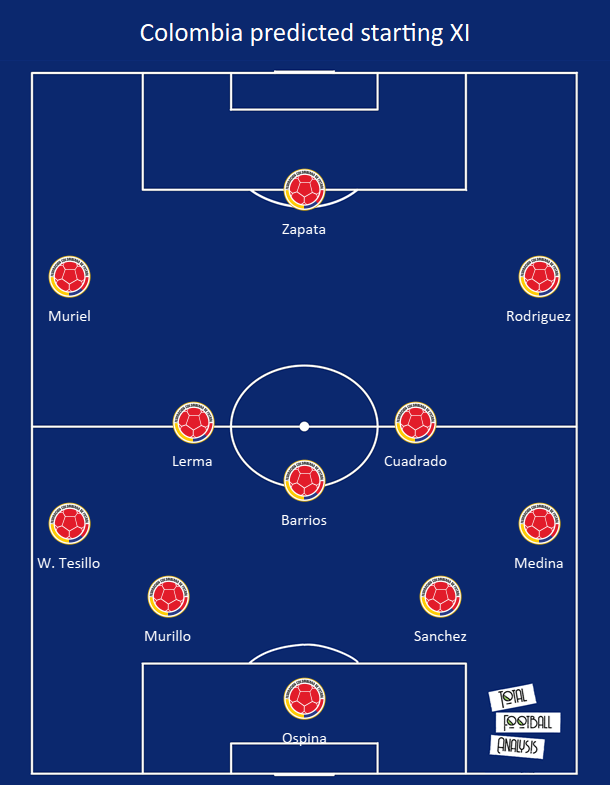
Looking at our predicted lineup here at the beginning of this tactical analysis, it’s extremely difficult to say for certain what the new coach is going to deploy. The 4-3-3 was Colombia’s preferred structure under Queiroz and it was also a very aggressive and attacking-minded setup that would often transition into a 4-2-4 as Cuadrado pushed forward to join the forward line. This in itself was a huge change compared to Pékerman’s 4-2-3-1/ 4-4-2 system, which was far more pragmatic in the first place.
However, considering Rueda won’t exactly have the time to experiment a lot, we’re predicting that there won’t be any huge changes for Colombia once the tournament rolls in. They may opt to play their cards close to the chest and try to keep their best and most effective tactics somewhat hidden for the upcoming World Cup in 2022.
That being said, the squad Rueda has at his disposal is still a good one. The likes of Everton‘s James Rodriguez, Luis Muriel, Juventus‘ and Serie A‘s Juan Cuadrado and young stars like Steven Alzate will surely have something to say in the tournament while the coach still has the services of reliable veterans like Radamel Falcao. The backline is likely to consist of Davinson Sanchez and either former Barcelona centre-back Yerry Mina or Jeison Murillo while the full-backs are still largely unknown.
Colombia have two potential approaches ahead of them – either go fully offensive with the likes of Santiago Arias and Frank Fabra or stick with a more balanced option by introducing more pragmatic choices like Stefan Medina.
Interestingly, as we will shortly see in the following graphic, Colombia are a team that’s blessed with exceptional defensive midfielders. If they decide to stick with Rueda’s preferred 4-2-3-1, we’re likely to see Wílmar Barrios and Mateus Uribe deployed as the double-pivot. In case of a 4-3-3, Barrios will be the team’s destroyer in the role of a no.6.
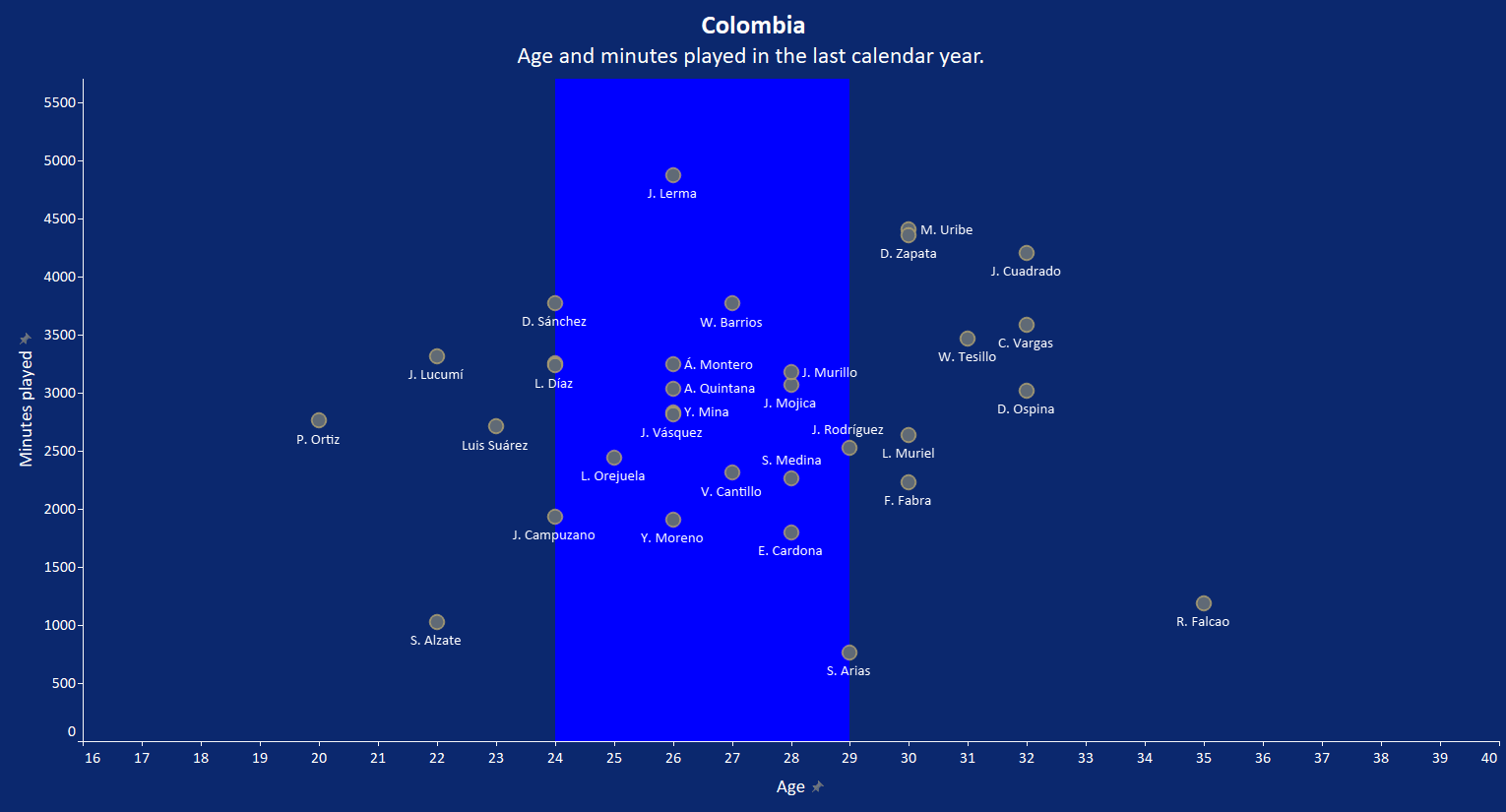
As for the front three, we know Rodríguez and Duván Zapata will most likely get the nod while the third man in attack could very well be Luis Muriel as he’s been one of their standout players despite not getting regular starting spots. Again, this largely depends on the structure Rueda plans to employ and variations are more than just likely.
Looking at the age chart and game time distribution in the last calendar year, we can see that Colombia’s veterans still play a huge role in the team. Similarly, players in their late peaks have a high minute tally too and going into the Copa – and even beyond it towards the next World Cup – they will have significant roles to play.
ATTACKING PHASE
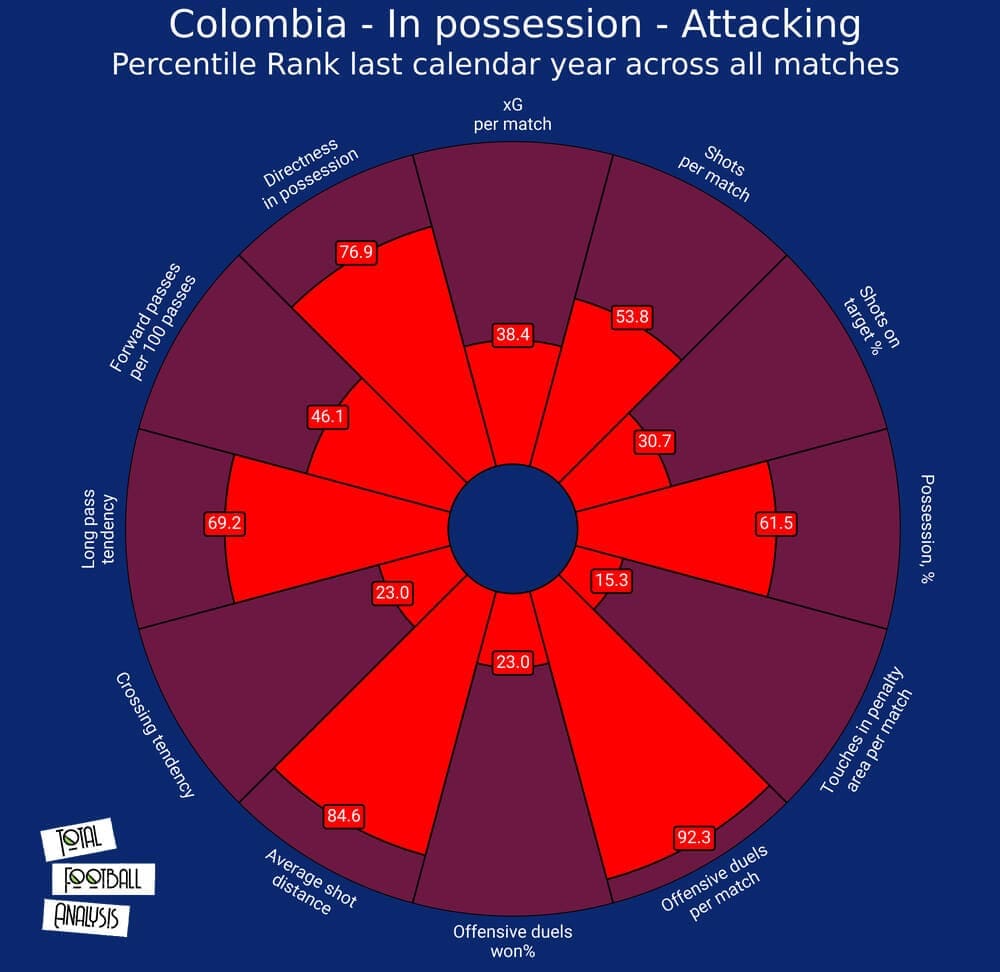
Under Queiroz, Colombia were a very direct team that had the tools to maintain control but often chose not to. As we can see from their attacking chart, they rank among the more direct and transitional teams that weren’t afraid to deploy fast, long balls over the top towards their striker. Interestingly, however, despite having a lethal forward in Falcao usually roaming the box, they didn’t really put that much focus on crossing the ball.
Instead, getting it to their main creative outlets before circulating it forward with speed and precision was the way to go. We can also see that their possession percentile ranking puts them among the teams that can dominate the ball if necessary and should the opportunity arise. However, this also reveals a flaw in their system.
Colombia’s expected goals (xG) values per game as well as their shots and shots on target suggest they were struggling to break teams down. They don’t register too many attempts per match and when we combine that with a rather long shot distance, we can conclude that not only were they not shooting often but when they were, it was not from ideal positions on the pitch.
Clearly, that is something that needs to change quickly under Rueda. Another big thing to note is that they are among the top 7.7% teams in offensive duels but are worse than 77% in winning them. This tells us they engage in 1v1 encounters often but are largely unsuccessful, which is definitely a part of the overall problem. But these were the stats before Rueda took over and it will be interesting to see how and if they change for the better.
As mentioned, the new coach’s preferred system is a 4-2-3-1 and compared to the former manager, we can expect him to be more positional and less focused on the transitional phase. At Chile and Atlético Nacional we saw something similar and with the personnel he’s got at Colombia, this style could indeed be replicated.
The main idea is to keep the ball more, recycle possession when that’s possible and beat the press or dismantle the block by spreading the pitch and use the wide players to their fullest potential. We’ve seen Rueda focus on these tactics before, utilising the overlapping full-backs and ball-carriers from the backline.
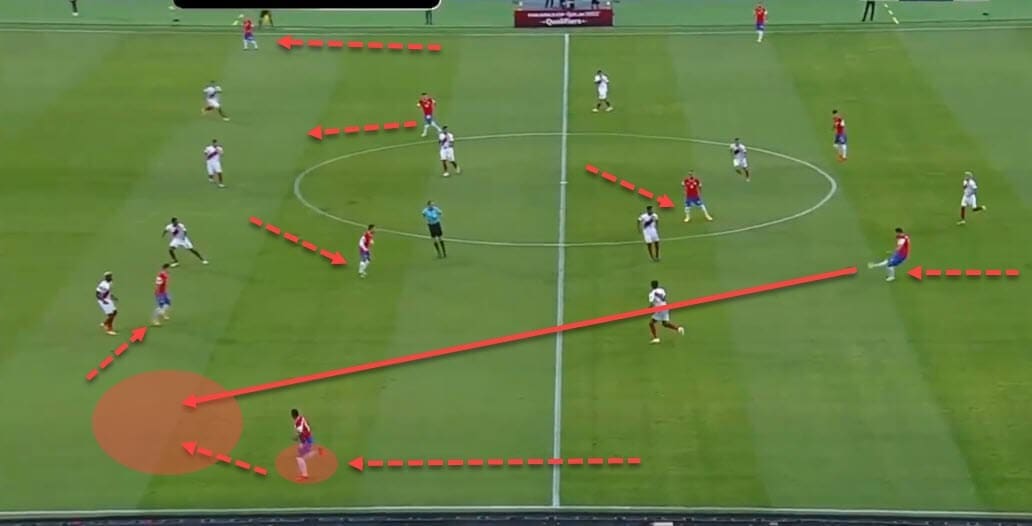
In such a scenario, the personnel and the structure matter a lot. If given the choice between Zapata and Radamel Falcao, Rueda is likely to go for the former due to his better hold-up play and link-up with the midfield. The latter lacks in these categories and is likely to be more of a liability if the new coach is indeed to implement such a system.
Of course, Falcao’s lethality in the box should not be overlooked but if Colombia are to focus on a possession-based style of play, having a striker with such attributes will be a must for the team. After all, we’ve seen Zapata perform that role decently for them before. Our next example shows us exactly that as his dropping movement and quick lay-offs are used to send Cuadrado into space out wide.
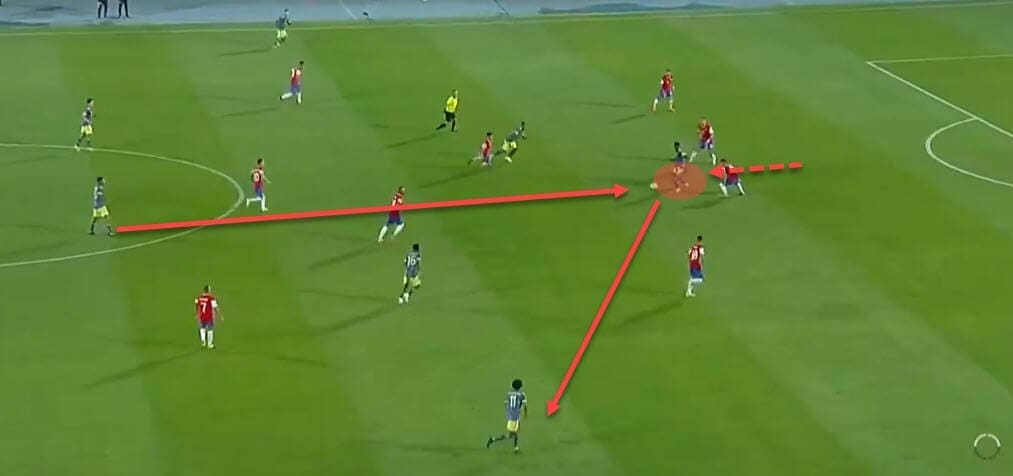
This works well even with the more direct approach, which used to be more of a trademark of the previous manager. Zapata is good at holding the ball and then waiting for the overlaps to happen and as such, can be used in the target-man role as well. But as we’ve mentioned earlier in this tactical analysis, we expect Colombia to shift away from that style of play under Rueda.
Playing to his players’ strengths, however, is still going to be a major factor. After all, there’s simply no time for major overhauls and while this is a big change in itself, it’s still something his players should, on paper, adapt to relatively quickly. Combined with a more balanced and less aggressive 4-2-3-1 with Rodríguez in the no.10 role and flanked by two pacey wingers, Colombia could finally improve their chance creation.
DEFENSIVE PHASE
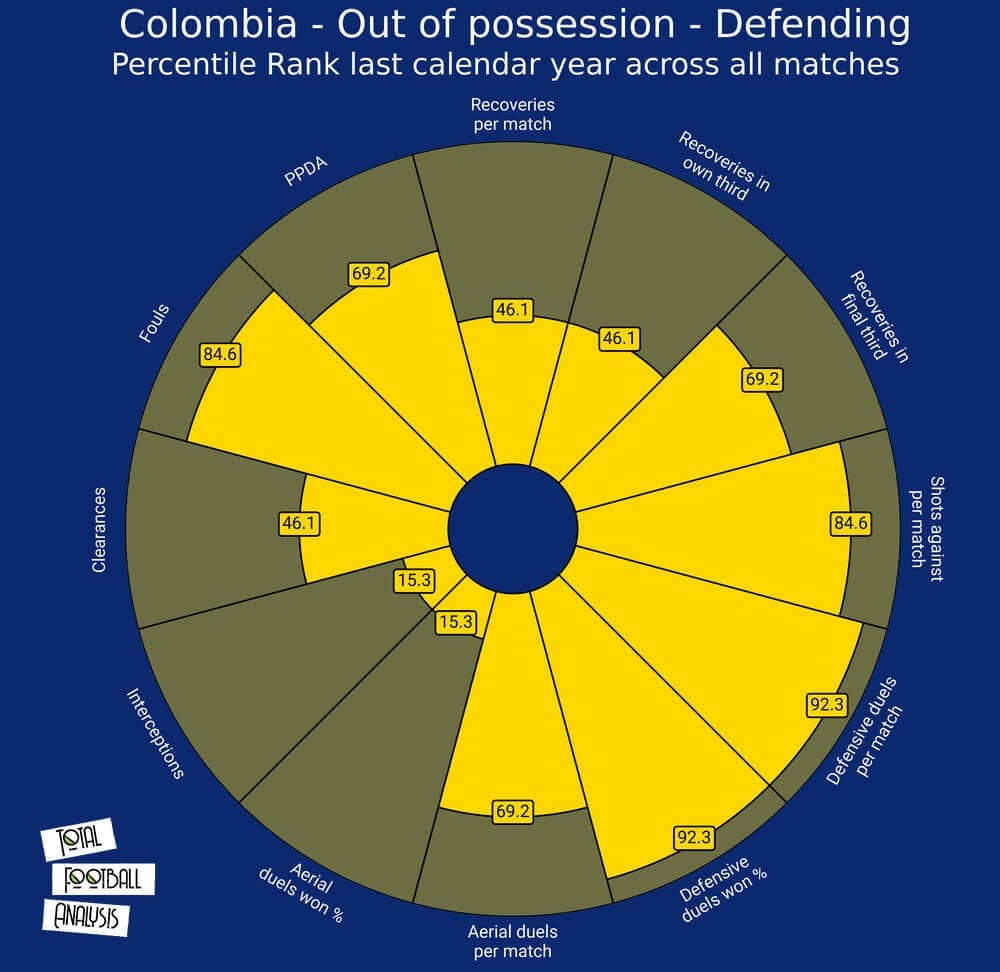
Just as was the case with their overall attacking tactics in this scout report, we still don’t know what Rueda is going to do with the team in regards to their defending. Looking at the chart, however, we can conclude that so far, Colombia have been a somewhat aggressive team off the ball. Granted, the 69.2 percentile ranking wouldn’t indicate as much but when we look at the number of recoveries in the final third, we see the makings of a team that likes to press when that option is available to them.
Similarly, their defensive duels per match and even more importantly, defensive duels won percentage, are on an even higher level, which complements the aforementioned recoveries. And it seems Colombia were generally more successful with that approach than regaining possession in their own half, as suggested by a significantly lower tally in recoveries in their own third, which immediately lowers the overall recoveries per match percentile ranking to 46.1.
Another important thing to note in their defensive style of play is the number of fouls they commit. As per our data, Colombia tally more fouls than 84.6% of other teams. This can impact their press while also playing an important role in stopping transitions, both of which we’ll analyse further down the line of this tactical analysis.
They also seem to be very vulnerable to aerial balls and crosses, implied by a very low percentile ranking in aerial duels won. Seeing that they tally a lot of aerial duels per match, the data could suggest other teams have also identified this as a weakness in the system and have tried exploiting it already. And seeing how they are among the worst teams in stopping opposition shots per match, it is safe to say this is becoming a problem for them.
So what can we expect Rueda to change, if anything? Replacing the reckless and overly punishing pressing with dosed aggression and a slightly milder mid-block could indeed be on the cards. We’ve seen Colombia assume a variation of a 4-1-4-1 that transitions into a more traditional 4-4-2 with the team slowly raising their defensive line.
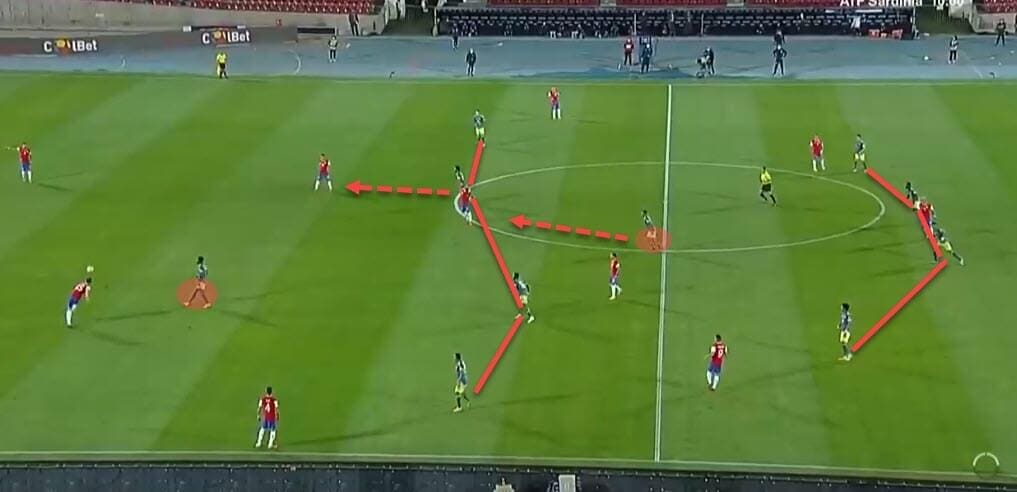
Generally speaking, the lone striker will be used to track the ball and disrupt the first line while the line of four behind him try to shut down any progressive passing channels. Once one of the midfielders jumps up, the destroyer who was positioned in front of the back four takes his place to complete the 4-4-2. When the opposition recycles the ball towards the flanks, the wide men will also make the transition forward, progressively transitioning their mid block to a high one and starting the more aggressive press.
Considering he doesn’t have as much time to implement an entirely different (and successful) defensive structure within weeks, it’s possible he sticks with a variation of the very same system we’ve seen so far. However, coming back to the data which tells us Colombia are not among the most proficient defenders out there, improvements will still be necessary.
How and if Rueda goes about making his changes, remains to be seen.
TRANSITIONS
Transitions used to be Colombia’s go-to tactics, as the initial attacking charts confirms as well. Aiming for their target man up front and trying to get the ball forward as quickly as possible in deadly counter-attacks was something that served them decently well in the years gone by. However, as previously mentioned, Rueda may want to step away from that style for the upcoming event(s).
Still, that doesn’t mean we won’t see a Colombia capable of executing such plans should the opportunity arise. We already talked about Zapata being key in their link-up play and sustaining pressure through possession and structural dismantling of the opposition. But the same is true for their success in transitional play. Having a clear outlet up front to aim for who also pins the defence and creates space is crucial.
Fortunately for Rueda, he’s inheriting a squad that’s already capable of such tactics. Our first example will deal with attacking transitions and shows us Zapata as the focal point up front while Colombia use their aggression to recover the ball and quickly get it to their ball-carriers in midfield.
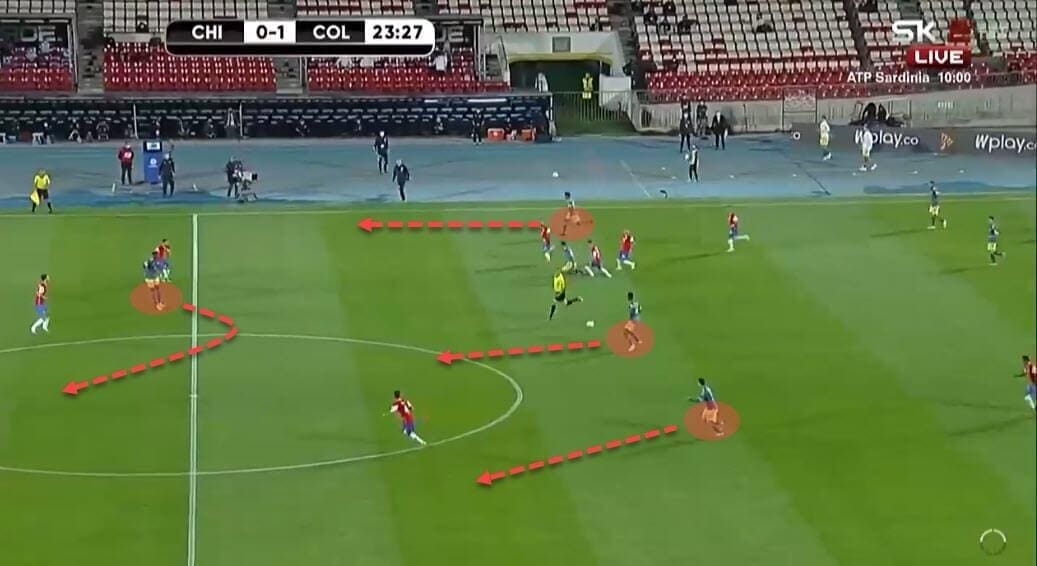
Equally important is to have good runners off the ball as well. Notice how in our example Colombia immediately have at least three outlets to aim for once the ball is recovered around the middle of the pitch. Using the pace they have in the wings will be crucial in executing good transitions, as will using their striker properly.
Zapata is pinning the defenders and that creates separation between the opposition’s backline and the midfield line, ultimately giving Colombia space to work with when carrying the ball forward. Creating such circumstances is key and Rueda does have the personnel to execute this properly.
Shifting over to defensive transitions, however, we encounter some of their weaknesses and potential problems for the new coach. We’ve seen Colombia assume high-pressing man-marking systems which raise their defensive line significantly and that, at times, has serious disadvantages should the press be broken by the opposition.
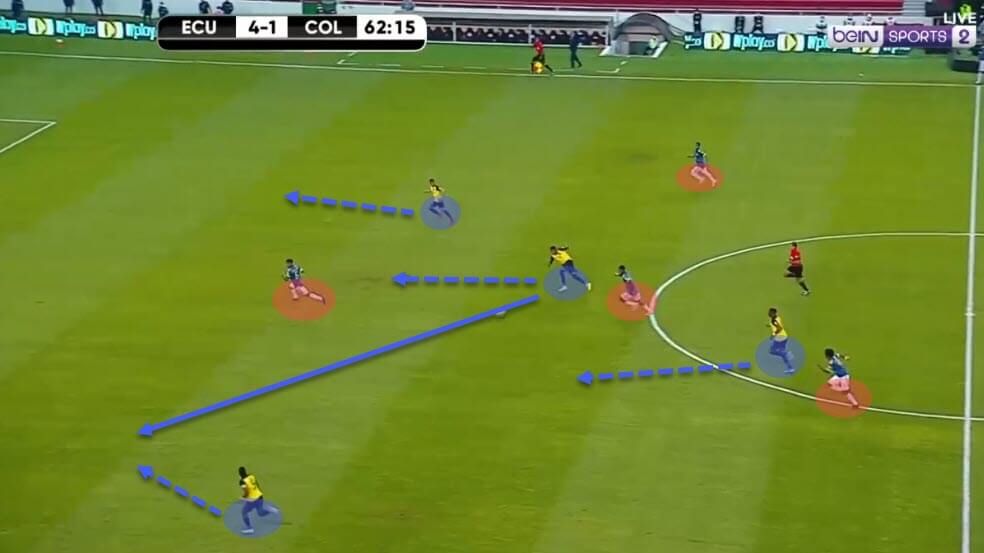
In our next example, we see Ecuador carving Colombia open through a quick interplay after a high recovery. Granted, this was not due to Colombia’s press being broken but still shows how pushing players forward in numbers can be extremely punishing when teams know how to exploit it. On a positive note, however, it does seem that they mostly have adequate runners who try to get back in time, often trying to maintain their numerical advantage over the counter-attacking team on the other side.
By limiting their aggression and using a more conservative mid-block, Rueda may succeed at preventing these situations when possible. But that is still something we can’t guarantee is going to happen at the upcoming Copa America tournament.
FORWARDS
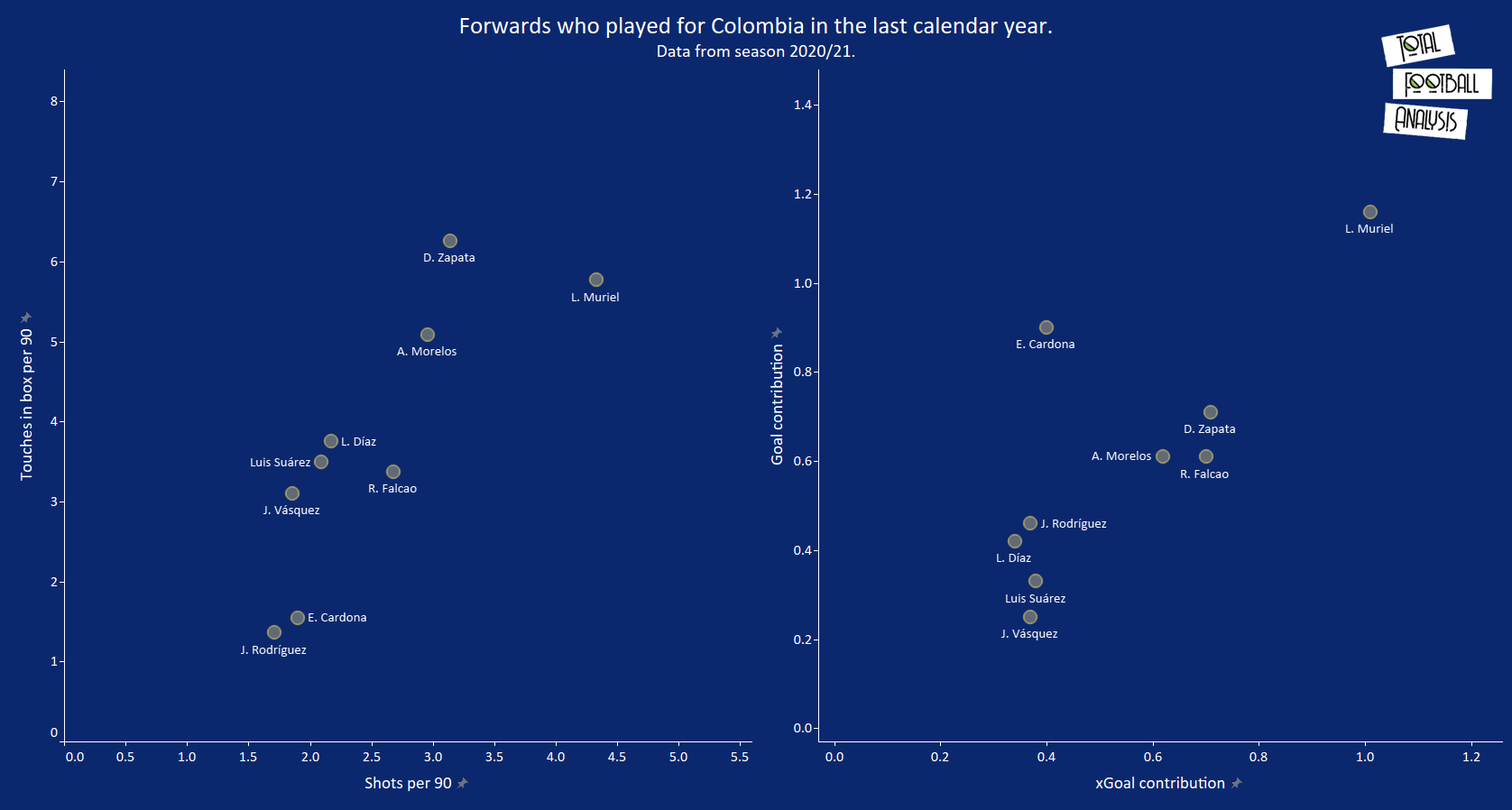
When we look at Colombia’s attacking firepower, we can immediately notice a couple of important things. Firstly, they do have quality players in their forward line, which is excellent news. However, both the depth and the dependence on a couple of main pieces of the jigsaw are the other side of the coin that needs addressing soon.
Zapata and Muriel are the obvious stand-outs in the chart as Colombia’s biggest presences in the box and in pure shooting output. Both players seem to shoot a lot and from close range while the latter tops the chart in terms of xGoal contribution (expected goals + expected assists), which are in line with his real Goal contribution (goals + assists).
Edwin Cardona is still an unknown quantity, considering his limited game time in the last calendar year and the fact he’s still in China. But it does seem like he’s finding himself in good positions to both score and assist while also overperforming his expected values. Alfredo Morelos is also someone who could get an honourable mention in the attacking metrics.
The 24-year-old has seen decent game time in the last calendar year and seems to be doing decently in both charts. Still, even with that being said, it feels like Colombia will depend on both Zapata and Muriel doing what they do best and bagging the goals. We shouldn’t forget Falcao, of course, whose lethality and fox in the box instincts can still be of value but considering the predicted change in system, he could see limited game time in the upcoming tournament.
It’s weird not seeing Rodríguez topping any of the metrics here but that also shows that when we exclude the forward line, or rather pure strikers and wingers specifically, their output suddenly drops. The Everton man will act as the number 10 or a winger on the right but it seems that he won’t score or directly threaten the goal that often despite the play generally still running through him.
MIDFIELDERS
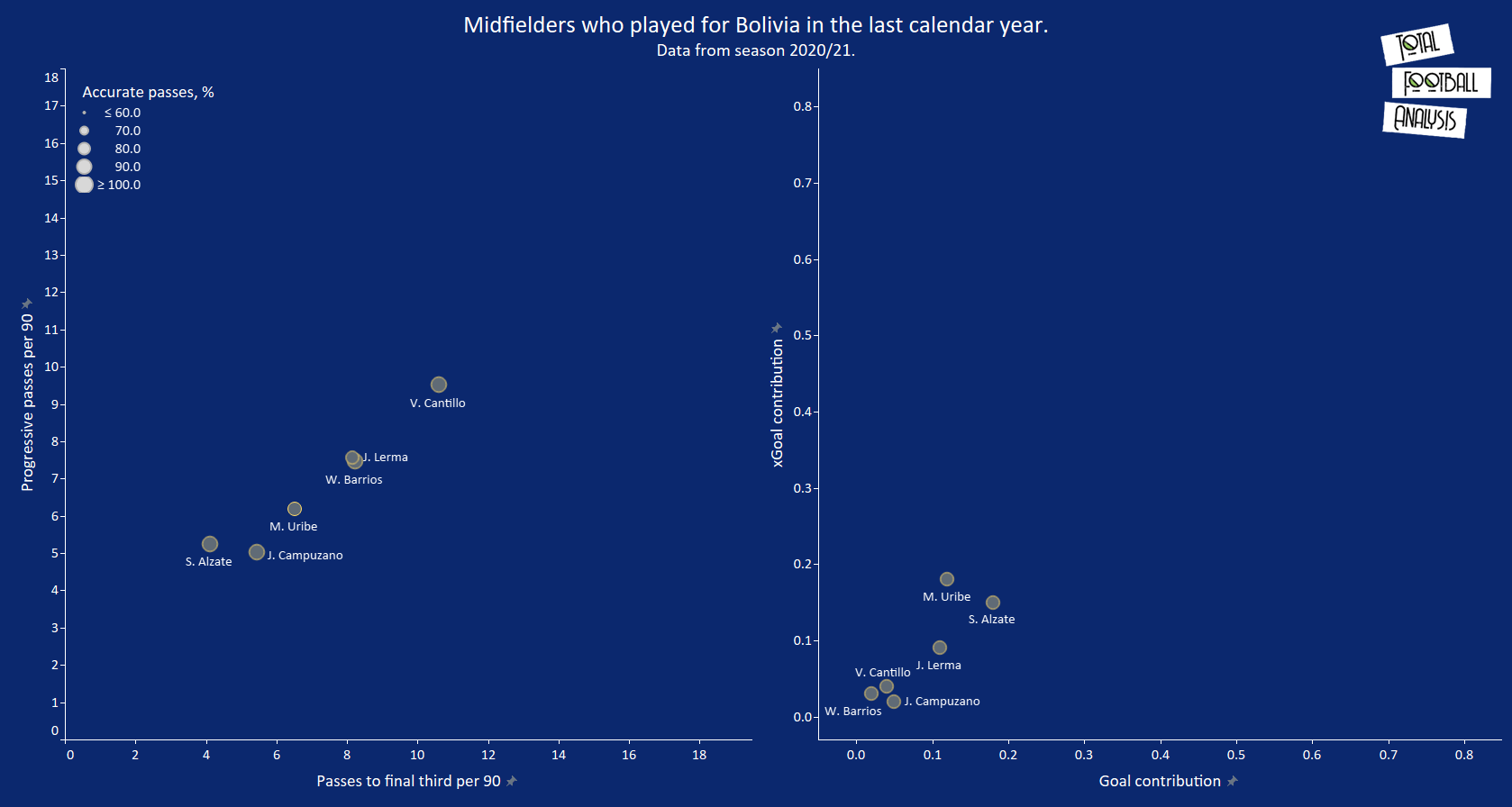
Judging the midfielders is also quite a difficult task. We’ve chosen their progression and final product metrics as good parameters when deciding the most important pieces of the jigsaw. Of course, a big part of this will depend on Rueda’s initial structure. Should he opt to keep Colombia’s 4-3-3, we’re likely to see a single pivot acting as a destroyer with two floating no.8s either side of him.
That system also makes better use of natural wingers on both flanks and gives them the option to play Rodríguez in a midfield role. However, if our predictions are correct, Rueda is likely to swap to a 4-2-3-1 system, opting to deploy a double-pivot partnership behind an attacking trio and a sole striker in Zapata. Now, looking at the numbers, we can see that Víctor Cantillo leads the line in terms of progression numbers, showing impressive values in both passes to final third per 90 and progressive passes per 90.
However, we can’t say for sure he’ll be in Rueda’s plans as much if the last calendar year is any indication at all. Recently he hasn’t been used as much but of course, all of that could change drastically with the new coach. Three of the players who are expected to play a part, however, are Uribe, Barrios and Jefferson Lerma, all of whom are still relatively high on the charts, which is a good sign for Colombia.
Uribe, in particular, has been improving a lot lately despite being 30 years of age. He could indeed be Barrios’ partner in crime should Rueda opt for a double-pivot structure. If not, expect Barrios to be the team’s no.6. The second chart analyses the midfield’s proficiency in delivering the final product, which, as alluded to, is not particularly impressive.
Uribe and Alzate lead the line but neither are exactly covering themselves in glory here. The numbers do improve only slightly if we count Rodríguez as a midfielder rather than a forward but even with his inclusion, Colombia still lack an offensive presence from the middle of the park. This not only puts an even bigger strain on their forwards but also makes them an easier team to defend against.
DEFENDERS
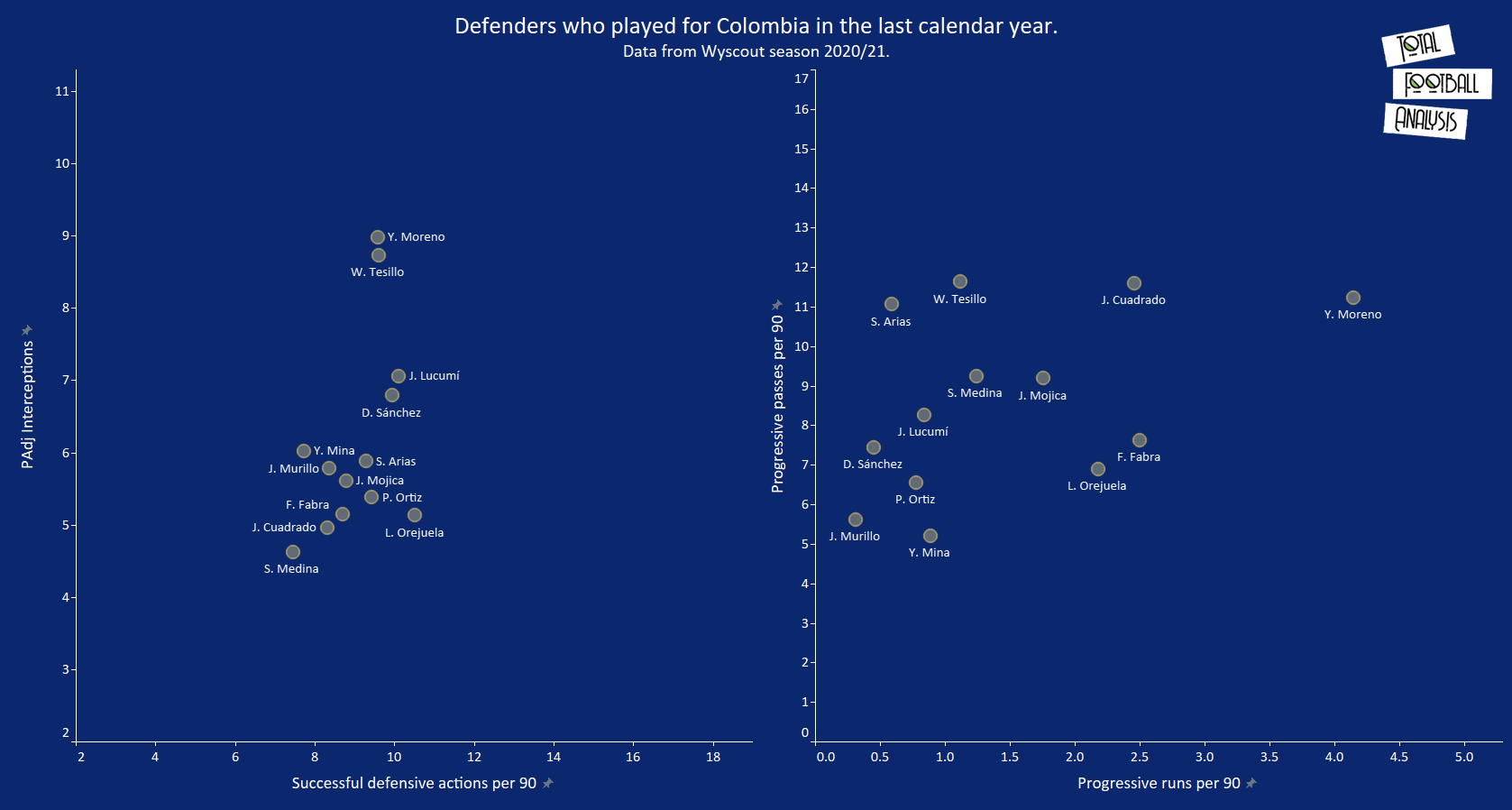
Finally, we’ll touch upon Colombia’s best defenders in two main metrics – defending and progression. We’ve opted for successful defensive actions and PAdj (possession-adjusted) interceptions as we feel those two will give us a clear picture of the most proficient defenders in the team. Interestingly, and perhaps worryingly for Rueda, the players that are likely to play key roles in the tournament don’t necessarily top the charts here.
Sánchez, Mina and Murrilo are players who could likely find their names on the starting XI sheet often but neither is among the best in the first chart to the left. In terms of defending efficiently, Yairo Moreno, William Tesillo and Jhon Lucumí are the names that stand out. The third player there has admittedly formed a decent partnership with Carlos Cuesta and they could make a surprise inclusion as a very young centre-back duo should Rueda decide to roll a dice a bit.
But given the whole narrative of the new manager sticking to the main and established players in the roster, we’re likely to see the two out of the first three defenders mentioned start in most games. Moving to the progression metrics, we actually have to keep in mind ball progression often comes from the full-back positions, which, in Colombia’s case, could still change drastically.
We’ve already explained how there are essentially two possible routes Rueda takes in the upcoming Copa America. Colombia basically have two contrasting approaches as clear options: either go aggressive and attacking-minded or more conservative. That decision will ultimately determine who starts. But regardless, we can see Tesillo and Arias as the most progressive passers from the backline while the likes of Moreno have the tendency to run with the ball a lot.
Cuadrado is listed here because of his deployment at the right-back position, which was an experiment that didn’t necessarily end that well so it’s questionable whether we’ll see it again soon. Still, we have to note that he offers excellent progression both via runs and passes when deployed in deeper positions on the pitch. However, having him closer to goal could still be far more beneficial for Colombia.
BEST PERFORMER
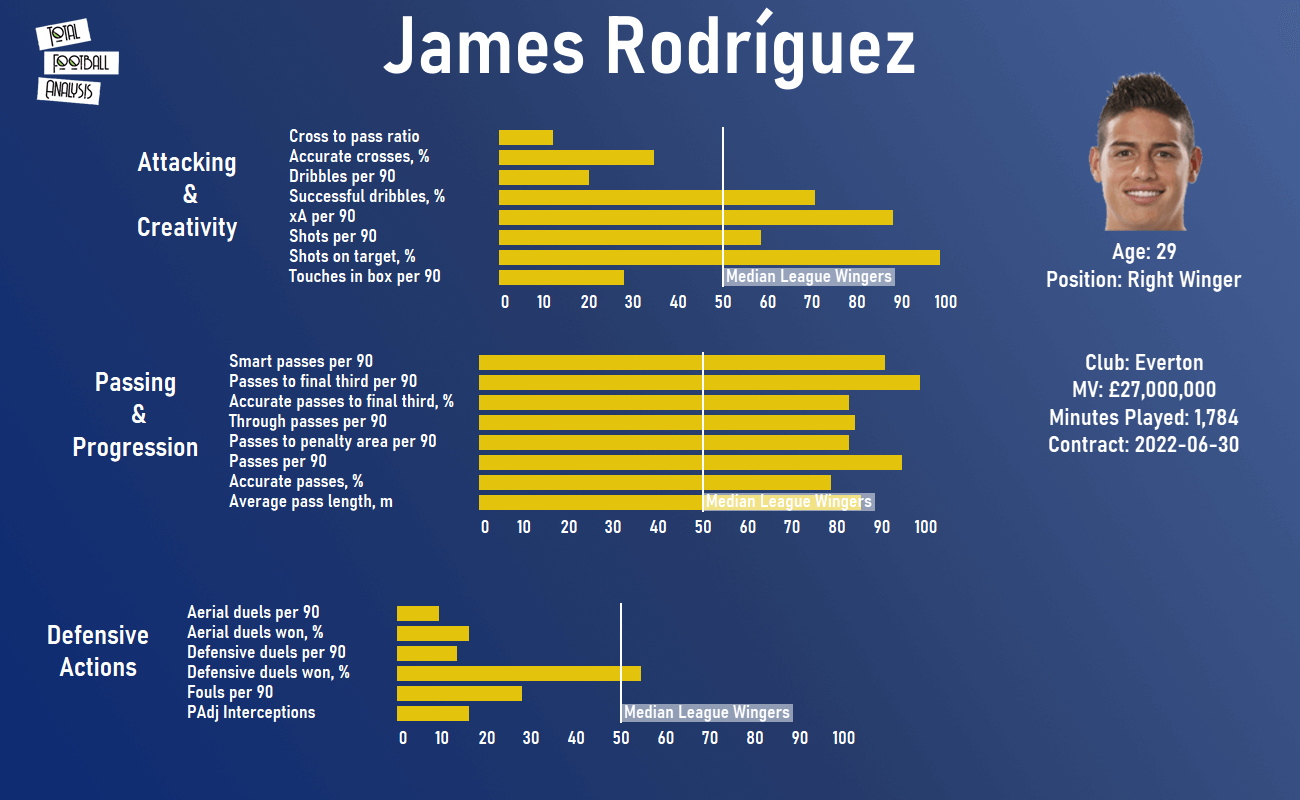
Putting Rodríguez as Colombia’s best performer might be stating the obvious but this has not really been a simple decision to make. The likes of Muriel and Cuadrado certainly deserve a shout while there are also some other less exciting players – mostly because of their roles – in the squad that would genuinely deserve this title. However, opting for Rodríguez seems reasonable since the major brunt of Colombia’s creative power will fall onto his shoulders.
The Premier League man is not always the one putting the finishing touches to actions, as we’ve already concluded, but his importance to the system should not be disregarded. This is especially true if Rueda opts to reintroduce the role of the attacking midfielder or the no.10 in his 4-2-3-1 structure. In that case, Rodríguez will play in arguably his best position and will therefore be able to influence games even more.
Looking at the stats, however, we can see why he’s so important despite being in his late prime years already. The Colombian is an elite creator, topping the charts when it comes to passing and progression and registering great numbers in expected assists per 90, successful dribbles percentage and shots on target percentage. He likes to shoot from outside the box too, which goes in line with Colombia’s overall attacking tactics that put a lot of emphasis on that approach.
Due to his limited participation with the team’s exploits in the last calendar year, his overall numbers have taken a dip but if fit, available and firing on all fronts, Rodríguez should still be the one to carry Colombia to potential success in the upcoming Copa America.
PREDICTIONS FOR THE TOURNAMENT
It’s difficult to completely write off Colombia with all the attacking talent they have at their disposal. However, their shaky defensive numbers and the fact they’re essentially heading into the event blind with little to no practice with their new coach, they could run into some problems along the way.
With that being said, we would still expect them to reach the knockout stages and then, if things go their way, even finish in the latter rounds of the tournament. How reasonable and possible that prediction is only time can tell.
But given the overall quality of the squad and the new coach’s established pedigree, it’s not entirely out of the question. Making a deep run would certainly be considered as a success story for almost any nation. Winning the whole thing, however, would be pushing it just a little, especially with the likes of Brazil, Chile and Argentina standing in their way.

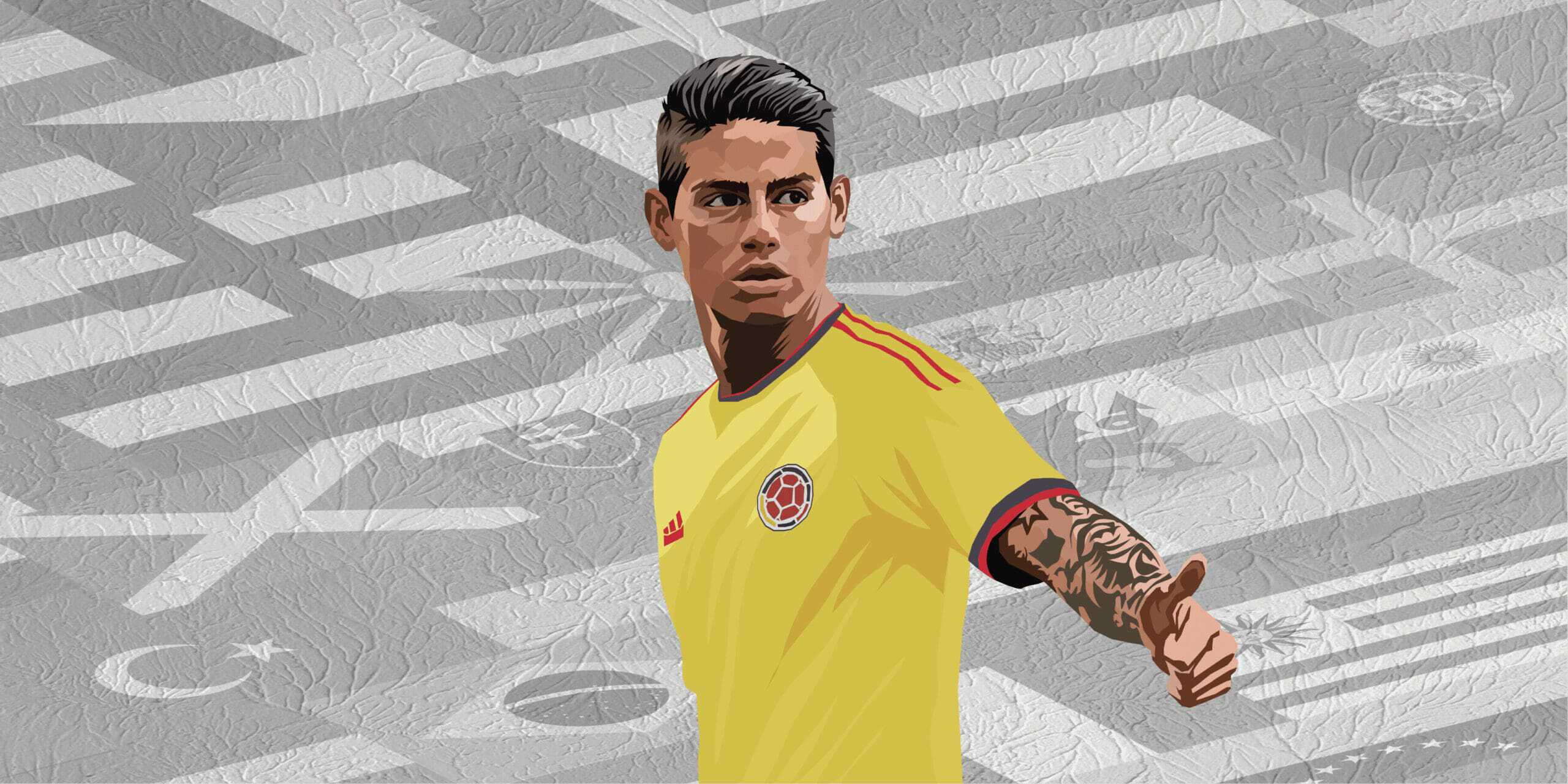




Comments